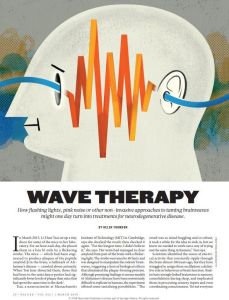Join getAbstract to access the summary!

Join getAbstract to access the summary!
Helen Thomson
Nature
How flashing lights, pink noise or other non-invasive approaches to taming brainwaves might one day turn into treatments for neurodegenerative disease.
Nature, 2018
What's inside?
Manipulating brainwaves to treat Alzheimer’s disease: a promising new treatment?
Recommendation
For decades, scientists have struggled to find treatments for neurodegenerative diseases like Alzheimer’s. In this article, science journalist Helen Thomson introduces readers to the exciting new world of wave therapy, or brainwave manipulation, which one day might be able to treat conditions as diverse as Alzheimer’s disease, schizophrenia, insomnia or premenstrual dysphoric disorder. getAbstract recommends this article to anyone interested in non-pharmacological treatments that promote neurological and mental health.
Summary
About the Author
Helen Thomson is a science journalist with an MSc in science communication from Imperial College London. She is the author of Unthinkable: An Extraordinary Journey Through the World’s Strangest Brains.


















Comment on this summary